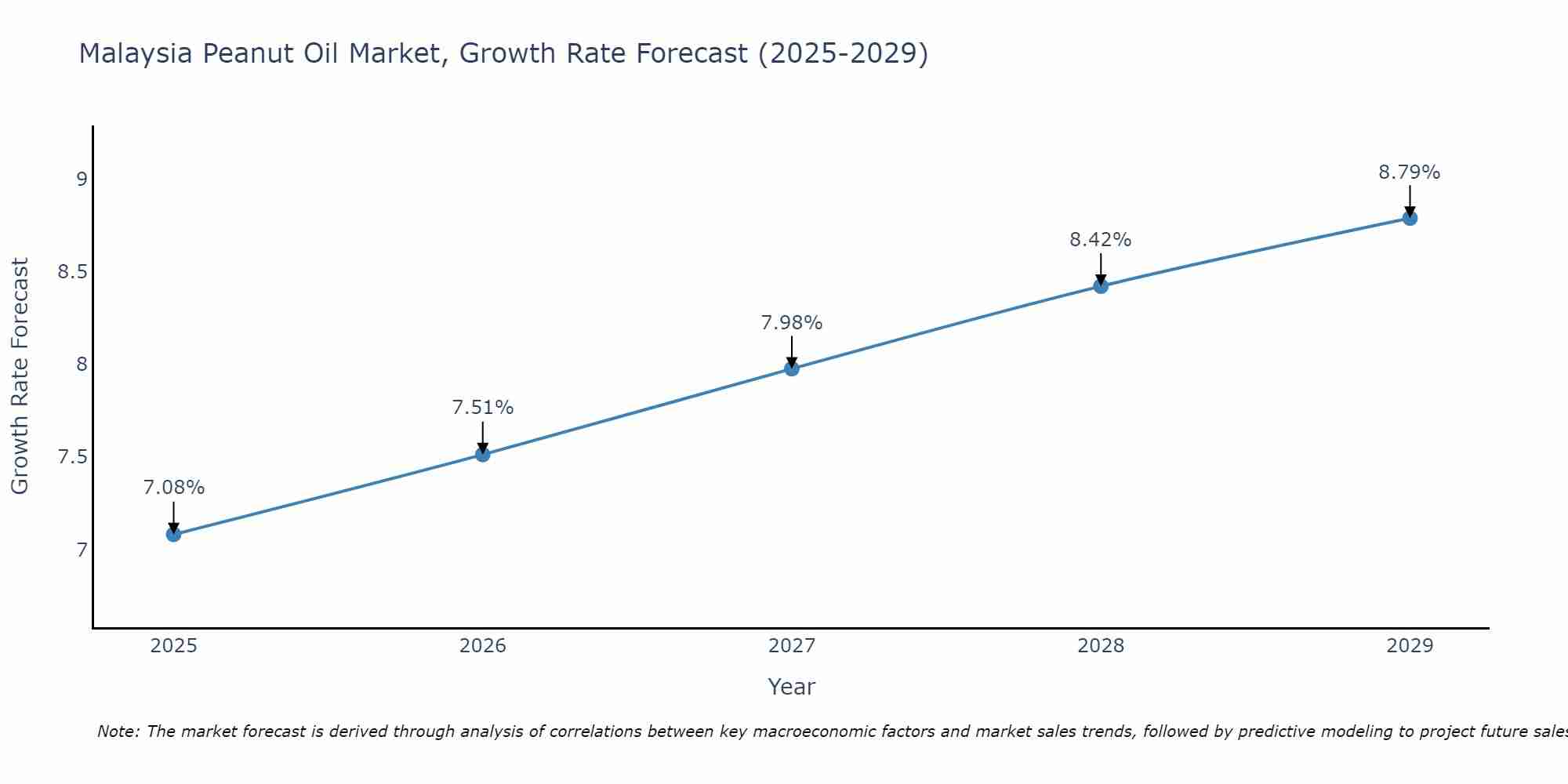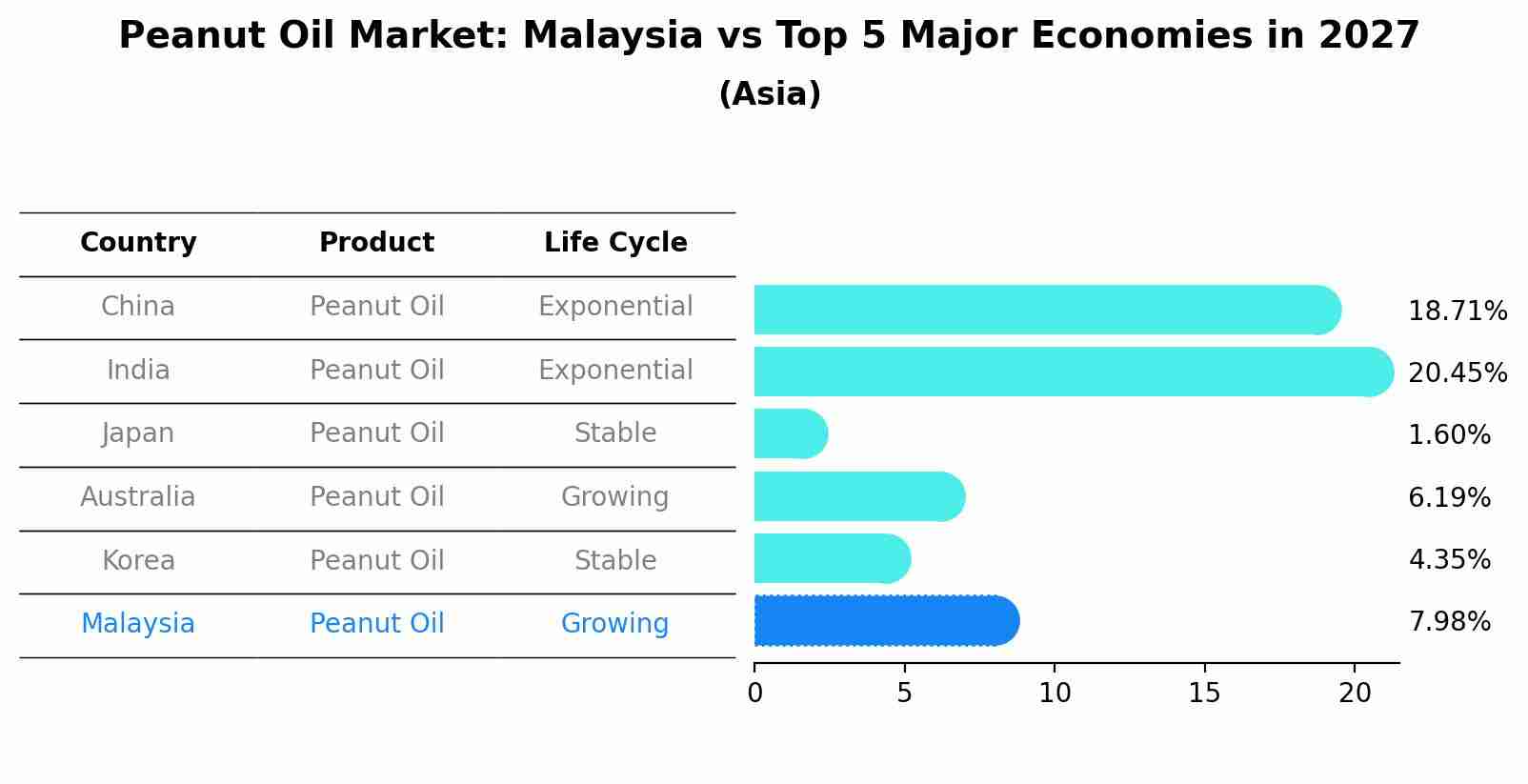Malaysia Peanut Oil Market (2025-2031) Outlook | Trends, Analysis, Value, Revenue, Companies, Share, Forecast, Size, Growth & Industry
| Product Code: ETC223586 | Publication Date: Aug 2022 | Updated Date: Aug 2025 | Product Type: Market Research Report | |
| Publisher: 6Wresearch | No. of Pages: 75 | No. of Figures: 35 | No. of Tables: 20 | |
Malaysia Peanut Oil Market Size Growth Rate
The Malaysia Peanut Oil Market is likely to experience consistent growth rate gains over the period 2025 to 2029. From 7.08% in 2025, the growth rate steadily ascends to 8.79% in 2029.

Peanut Oil Market: Malaysia vs Top 5 Major Economies in 2027 (Asia)
By 2027, Malaysia's Peanut Oil market is forecasted to achieve a growing growth rate of 7.98%, with China leading the Asia region, followed by India, Japan, Australia and South Korea.

Malaysia Peanut Oil Market Synopsis
The Malaysia peanut oil market continues to exhibit steady growth due to its versatility and health-conscious consumer trends. Peanut oil, known for its high smoke point and mild flavor, remains a popular choice for cooking and frying in Malaysia households and the foodservice industry. With increasing awareness of its heart-healthy monounsaturated fats and the growth of the culinary sector, the demand for peanut oil is expected to remain robust. However, the market may face some challenges from the competition with other vegetable oils and growing health concerns. Innovations in packaging, quality, and promotion of the oil`s nutritional benefits could help sustain its market share.
Drivers of the Market
The Malaysia peanut oil market is expected to experience growth due to various factors. One of the key drivers is the versatile use of peanut oil in cooking, especially in Malaysia and Southeast Asian cuisines. The growing food industry and the popularity of fried and processed foods contribute to the demand for peanut oil. Additionally, the perceived health benefits of peanut oil, such as its heart-healthy monounsaturated fats, further boost its market prospects. Malaysia peanut oil market is also influenced by its peanut farming industry and the availability of raw materials.
Challenges of the Market
The Malaysia peanut oil market encounters challenges related to allergen concerns and competition from other cooking oils. Ensuring clear allergen labeling and promoting the unique qualities of peanut oil are vital for market success.
COVID 19 Impact on the Market
The Malaysia peanut oil market experienced fluctuations during the pandemic. The initial lockdowns and changes in consumer behavior affected the demand for cooking oils, including peanut oil. However, as the situation stabilized, the market regained traction. The versatility of peanut oil, particularly in Asian cuisine, continues to drive its demand. Additionally, the market may see opportunities in the growing trend of natural and unprocessed food products.
Key Players in the Market
Major players in the Malaysia Peanut Oil market include international brands like Bunge Limited, Archer Daniels Midland Company (ADM), and Lam Soon Group. These companies are involved in the production and distribution of peanut oil, which is a common cooking oil in Malaysia.
Key Highlights of the Report:
- Malaysia Peanut Oil Market Outlook
- Market Size of Malaysia Peanut Oil Market, 2024
- Forecast of Malaysia Peanut Oil Market, 2031
- Historical Data and Forecast of Malaysia Peanut Oil Revenues & Volume for the Period 2021-2031
- Malaysia Peanut Oil Market Trend Evolution
- Malaysia Peanut Oil Market Drivers and Challenges
- Malaysia Peanut Oil Price Trends
- Malaysia Peanut Oil Porter's Five Forces
- Malaysia Peanut Oil Industry Life Cycle
- Historical Data and Forecast of Malaysia Peanut Oil Market Revenues & Volume By Type for the Period 2021-2031
- Historical Data and Forecast of Malaysia Peanut Oil Market Revenues & Volume By Refined for the Period 2021-2031
- Historical Data and Forecast of Malaysia Peanut Oil Market Revenues & Volume By Unrefined for the Period 2021-2031
- Historical Data and Forecast of Malaysia Peanut Oil Market Revenues & Volume By Application for the Period 2021-2031
- Historical Data and Forecast of Malaysia Peanut Oil Market Revenues & Volume By Personal Care for the Period 2021-2031
- Historical Data and Forecast of Malaysia Peanut Oil Market Revenues & Volume By Food for the Period 2021-2031
- Historical Data and Forecast of Malaysia Peanut Oil Market Revenues & Volume By Pharmaceuticals for the Period 2021-2031
- Historical Data and Forecast of Malaysia Peanut Oil Market Revenues & Volume By Other Applications for the Period 2021-2031
- Malaysia Peanut Oil Import Export Trade Statistics
- Market Opportunity Assessment By Type
- Market Opportunity Assessment By Application
- Malaysia Peanut Oil Top Companies Market Share
- Malaysia Peanut Oil Competitive Benchmarking By Technical and Operational Parameters
- Malaysia Peanut Oil Company Profiles
- Malaysia Peanut Oil Key Strategic Recommendations
Frequently Asked Questions About the Market Study (FAQs):
1 Executive Summary |
2 Introduction |
2.1 Key Highlights of the Report |
2.2 Report Description |
2.3 Market Scope & Segmentation |
2.4 Research Methodology |
2.5 Assumptions |
3 Malaysia Peanut Oil Market Overview |
3.1 Malaysia Country Macro Economic Indicators |
3.2 Malaysia Peanut Oil Market Revenues & Volume, 2021 & 2031F |
3.3 Malaysia Peanut Oil Market - Industry Life Cycle |
3.4 Malaysia Peanut Oil Market - Porter's Five Forces |
3.5 Malaysia Peanut Oil Market Revenues & Volume Share, By Type, 2021 & 2031F |
3.6 Malaysia Peanut Oil Market Revenues & Volume Share, By Application, 2021 & 2031F |
4 Malaysia Peanut Oil Market Dynamics |
4.1 Impact Analysis |
4.2 Market Drivers |
4.2.1 Increasing consumer awareness about the health benefits of peanut oil |
4.2.2 Growing demand for natural and organic food products |
4.2.3 Rising adoption of peanut oil in various cuisines in Malaysia |
4.3 Market Restraints |
4.3.1 Fluctuating prices of raw peanuts impacting production costs |
4.3.2 Competition from other cooking oils like palm oil and coconut oil |
4.3.3 Regulatory challenges related to food safety standards and certifications |
5 Malaysia Peanut Oil Market Trends |
6 Malaysia Peanut Oil Market, By Types |
6.1 Malaysia Peanut Oil Market, By Type |
6.1.1 Overview and Analysis |
6.1.2 Malaysia Peanut Oil Market Revenues & Volume, By Type, 2021-2031F |
6.1.3 Malaysia Peanut Oil Market Revenues & Volume, By Refined, 2021-2031F |
6.1.4 Malaysia Peanut Oil Market Revenues & Volume, By Unrefined, 2021-2031F |
6.2 Malaysia Peanut Oil Market, By Application |
6.2.1 Overview and Analysis |
6.2.2 Malaysia Peanut Oil Market Revenues & Volume, By Personal Care, 2021-2031F |
6.2.3 Malaysia Peanut Oil Market Revenues & Volume, By Food, 2021-2031F |
6.2.4 Malaysia Peanut Oil Market Revenues & Volume, By Pharmaceuticals, 2021-2031F |
6.2.5 Malaysia Peanut Oil Market Revenues & Volume, By Other Applications, 2021-2031F |
7 Malaysia Peanut Oil Market Import-Export Trade Statistics |
7.1 Malaysia Peanut Oil Market Export to Major Countries |
7.2 Malaysia Peanut Oil Market Imports from Major Countries |
8 Malaysia Peanut Oil Market Key Performance Indicators |
8.1 Consumer adoption rate of peanut oil in cooking |
8.2 Number of new product launches featuring peanut oil |
8.3 Percentage increase in peanut oil imports and exports in Malaysia |
9 Malaysia Peanut Oil Market - Opportunity Assessment |
9.1 Malaysia Peanut Oil Market Opportunity Assessment, By Type, 2021 & 2031F |
9.2 Malaysia Peanut Oil Market Opportunity Assessment, By Application, 2021 & 2031F |
10 Malaysia Peanut Oil Market - Competitive Landscape |
10.1 Malaysia Peanut Oil Market Revenue Share, By Companies, 2024 |
10.2 Malaysia Peanut Oil Market Competitive Benchmarking, By Operating and Technical Parameters |
11 Company Profiles |
12 Recommendations |
13 Disclaimer |
- Single User License$ 1,995
- Department License$ 2,400
- Site License$ 3,120
- Global License$ 3,795
Search
Related Reports
- ASEAN Bearings Market (2025-2031) | Strategy, Consumer Insights, Analysis, Investment Trends, Opportunities, Growth, Size, Share, Industry, Revenue, Segments, Value, Segmentation, Supply, Forecast, Restraints, Outlook, Competition, Drivers, Trends, Demand, Pricing Analysis, Competitive, Strategic Insights, Companies, Challenges
- Europe Flooring Market (2025-2031) | Outlook, Share, Industry, Trends, Forecast, Companies, Revenue, Size, Analysis, Growth & Value
- Saudi Arabia Manlift Market (2025-2031) | Outlook, Size, Growth, Trends, Companies, Industry, Revenue, Value, Share, Forecast & Analysis
- Uganda Excavator, Crane, and Wheel Loaders Market (2025-2031) | Strategy, Consumer Insights, Analysis, Investment Trends, Opportunities, Growth, Size, Share, Industry, Revenue, Segments, Value, Segmentation, Supply, Forecast, Restraints, Outlook, Competition, Drivers, Trends, Demand, Pricing Analysis, Competitive, Strategic Insights, Companies, Challenges
- Rwanda Excavator, Crane, and Wheel Loaders Market (2025-2031) | Strategy, Consumer Insights, Analysis, Investment Trends, Opportunities, Growth, Size, Share, Industry, Revenue, Segments, Value, Segmentation, Supply, Forecast, Restraints, Outlook, Competition, Drivers, Trends, Demand, Pricing Analysis, Competitive, Strategic Insights, Companies, Challenges
- Kenya Excavator, Crane, and Wheel Loaders Market (2025-2031) | Strategy, Consumer Insights, Analysis, Investment Trends, Opportunities, Growth, Size, Share, Industry, Revenue, Segments, Value, Segmentation, Supply, Forecast, Restraints, Outlook, Competition, Drivers, Trends, Demand, Pricing Analysis, Competitive, Strategic Insights, Companies, Challenges
- Angola Excavator, Crane, and Wheel Loaders Market (2025-2031) | Strategy, Consumer Insights, Analysis, Investment Trends, Opportunities, Growth, Size, Share, Industry, Revenue, Segments, Value, Segmentation, Supply, Forecast, Restraints, Outlook, Competition, Drivers, Trends, Demand, Pricing Analysis, Competitive, Strategic Insights, Companies, Challenges
- Israel Intelligent Transport System Market (2025-2031) | Strategy, Consumer Insights, Analysis, Investment Trends, Opportunities, Growth, Size, Share, Industry, Revenue, Segments, Value, Segmentation, Supply, Forecast, Restraints, Outlook, Competition, Drivers, Trends, Demand, Pricing Analysis, Competitive, Strategic Insights, Companies, Challenges
- Uganda Precast and Aggregate Market (2025-2031) | Strategy, Consumer Insights, Analysis, Investment Trends, Opportunities, Growth, Size, Share, Industry, Revenue, Segments, Value, Segmentation, Supply, Forecast, Restraints, Outlook, Competition, Drivers, Trends, Demand, Pricing Analysis, Competitive, Strategic Insights, Companies, Challenges
- Australia IT Asset Disposal Market (2025-2031) | Strategy, Consumer Insights, Analysis, Investment Trends, Opportunities, Growth, Size, Share, Industry, Revenue, Segments, Value, Segmentation, Supply, Forecast, Restraints, Outlook, Competition, Drivers, Trends, Demand, Pricing Analysis, Competitive, Strategic Insights, Companies, Challenges
Industry Events and Analyst Meet
Our Clients
Whitepaper
- Middle East & Africa Commercial Security Market Click here to view more.
- Middle East & Africa Fire Safety Systems & Equipment Market Click here to view more.
- GCC Drone Market Click here to view more.
- Middle East Lighting Fixture Market Click here to view more.
- GCC Physical & Perimeter Security Market Click here to view more.
6WResearch In News
- Doha a strategic location for EV manufacturing hub: IPA Qatar
- Demand for luxury TVs surging in the GCC, says Samsung
- Empowering Growth: The Thriving Journey of Bangladesh’s Cable Industry
- Demand for luxury TVs surging in the GCC, says Samsung
- Video call with a traditional healer? Once unthinkable, it’s now common in South Africa
- Intelligent Buildings To Smooth GCC’s Path To Net Zero













